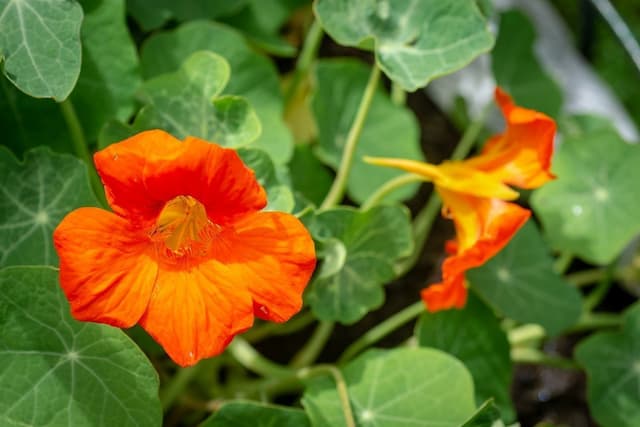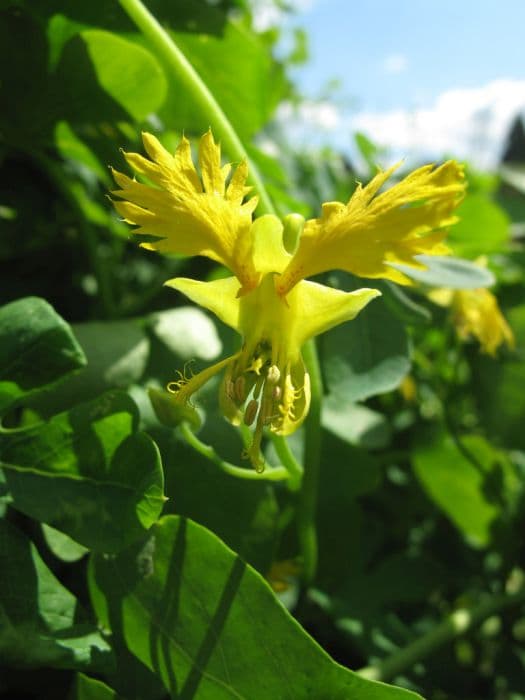Mashua Tropaeolum tuberosum var. lineomaculatum 'Ken Aslet'

ABOUT
This plant can be recognized by its distinct features, including its vibrant flowers and ornamental foliage. It commonly carries the name 'Ken Aslet' and is a variety of what many refer to as "flame flower." The leaves are generally an attractive green, often with a hint of blue, and can be heart or shield-shaped with subtle variegation. This variegation typically includes lighter streaks or mottling that contrasts with the darker green base color of the leaves. The signature appeal of this plant, however, lies in its striking flowers. They boast a rich, orange to red hue and resemble a flame in both color and form, with their distinctive spur adding to their unique appearance. These petals often display delicate veins or streaks, which can be a darker or lighter shade than the rest of the flower, adding to the visual interest. This ornamental plant often grows in a sprawling manner, with stems that can trail or climb, giving it a versatile utility in gardens. The tubers of this variety, while similar to those of its kind, are usually cultivated for their ornamental value rather than consumption. The aesthetic combination of its radiant flowers and appealing green foliage makes it a popular choice for garden enthusiasts seeking to add a touch of vibrancy to their outdoor spaces.
About this plant
 Names
NamesFamily
Tropaeolaceae.
Synonyms
Ken Aslet, Variegated Nasturtium, Mashua.
Common names
Tropaeolum tuberosum var. lineamaculatum 'Ken Aslett'
 Toxicity
ToxicityTo humans
The common name of Tropaeolum tuberosum var. lineomaculatum 'Ken Aslet' is Mashua. Generally, mashua is not considered toxic to humans and, in fact, is an edible tuber that is often consumed in some parts of the world, particularly in the Andes. However, like any other food source, it is essential to prepare it properly. Uncooked or improperly prepared mashua tubers can contain irritating substances and may lead to gastrointestinal discomfort if consumed in large quantities. Symptoms of irritation could include indigestion, gas, and abdominal pain. In most cases, consuming properly prepared mashua as part of a regular diet poses no serious risk to human health.
To pets
The common name of Tropaeolum tuberosum var. lineomaculatum 'Ken Aslet' is Mashua. Mashua is not widely recognized as a toxic plant to pets. However, it's always possible that a pet could have a sensitive reaction to eating plants that are not typically part of its diet. If a pet does ingest mashua, particularly in large amounts or in its raw form, they could experience symptoms similar to those in humans, including gastrointestinal upset, such as vomiting or diarrhea. To ensure the safety of pets, it's best to prevent them from consuming plants that are not meant for their species and to keep any potential irritants out of reach. If a pet does show symptoms of illness after ingesting any plant material, it's advisable to consult a veterinarian.
 Characteristics
CharacteristicsLife cycle
Perennials
Foliage type
Deciduous
Color of leaves
Green
Flower color
Orange
Height
3 feet (0.9 meters)
Spread
2 feet (0.6 meters)
Plant type
Tuber
Hardiness zones
9
Native area
South America
Benefits
 General Benefits
General Benefits- Ornamental Value: Its vibrant orange-yellow flowers and distinctive foliage make it a visually appealing addition to gardens and landscapes.
- Edible Tubers: The plant produces edible tubers known as 'Mashua', which can be a nutritious supplement to the diet.
- Cold Tolerance: It is resistant to cooler temperatures, which makes it suitable for cultivation in temperate regions.
- Pest Resistance: The plant is known for having natural resistance to some pests, which can help protect nearby plants.
- Companion Planting: It can be used in companion planting to deter certain pests from more sensitive plants.
- Low Maintenance: It is relatively easy to care for, requiring minimal upkeep once established in the right conditions.
- Pollinator Attraction: The flowers attract bees and other pollinators, thus aiding in the pollination of gardens and crops.
- Cultural Significance: In Andean cultures, it's an important traditional crop, valued for its nutritional and cultural importance.
- Diversity in Planting: Adds botanical diversity to gardens with its unique characteristics, enriching the local flora.
 Medical Properties
Medical Properties- Antiscorbutic: Nasturtium (the common name for Tropaeolum species) has a high vitamin C content, which can prevent and treat scurvy.
- Antimicrobial: It contains compounds that may have antimicrobial properties, potentially helping fight off certain bacteria and fungi.
- Antifungal: Similar to antimicrobial properties, it may help in inhibiting the growth of fungi.
- Expectorant: Nasturtium has been traditionally used to help clear the respiratory passages.
- Diuretic: The plant is believed to promote the production of urine, aiding in the removal of excess water and toxins from the body.
 Air-purifying Qualities
Air-purifying QualitiesThis plant is not specifically known for air purifying qualities.
 Other Uses
Other Uses- Mashua 'Ken Aslet' tubers can be used as a natural soap substitute due to their cleansing saponins, making them helpful for washing clothes or hands when traditional soap is unavailable.
- Flowers of the Mashua 'Ken Aslet' can be added to salads or used as an edible garnish to provide a spicy flavor and decorative touch to various dishes.
- Due to its vibrant flowers, the Mashua 'Ken Aslet' is often planted in ornamental gardens for aesthetic purposes and to attract pollinators like bees and hummingbirds.
- The leaves of the Mashua 'Ken Aslet' can be used to create a natural yellow to orange dye for textiles, providing an eco-friendly coloring option for fabrics.
- Mashua 'Ken Aslet' can be integrated into permaculture systems as a ground cover crop to suppress weeds and maintain soil moisture.
- The plant can be used in companion planting to deter pests such as aphids and certain beetles, protecting nearby crops with its repellent properties.
- Tubers of the Mashua 'Ken Aslet' can be used as a sustainable feed for livestock, especially in regions where other fodder crops might not be as easily grown.
- The vibrant and unique appearance of Mashua 'Ken Aslet' can be used by artists for botanical drawing and painting, providing a unique subject with its interesting shapes and colors.
- Dried stems and vines of the plant can provide a natural trellis for other climbing plants, lending support and structure to a mixed planting arrangement.
- The tubers can be creatively carved into stamps for crafting purposes, lending their shapes to fabric or paper printing techniques.
Interesting Facts
 Feng Shui
Feng ShuiThe Nasturtium is not used in Feng Shui practice.
 Zodiac Sign Compitability
Zodiac Sign CompitabilityThe Nasturtium is not used in astrology practice.
 Plant Symbolism
Plant Symbolism- Energy and Vitality: The vibrant flowers of the Nasturtium 'Ken Aslet' are symbolic of an energetic spirit and liveliness, infusing a sense of vitality wherever they grow.
- Victory and Conquest: Nasturtium, derived from the Latin 'tropaeum,' refers to a battlefield trophy; thus, it symbolizes triumph and the overcoming of obstacles.
- Optimism and Hope: The bright, uplifting colors of the Nasturtium 'Ken Aslet' flowers represent positivity, providing a sense of hope and encouragement.
- Resilience and Adaptability: As a hardy plant that can thrive in various conditions, Nasturtium 'Ken Aslet' stands for the ability to persist and adapt to life's challenges.
- Patriotism and National Pride: The fiery colors of the Nasturtium 'Ken Aslet' can evoke feelings of patriotism and pride in one's country, especially in regions where it's a native species.
 Water
WaterThe Mashua plant, commonly known as Ken Aslet, should be watered regularly to keep the soil evenly moist, especially during the growing season. Aim to water the plant when the top inch of soil feels dry to the touch. A general rule is to provide about 1 gallon of water per week, but this can vary depending on climate conditions and the plant's environment. Avoid overwatering, as this can lead to root rot. During the dormant period in winter, reduce watering significantly but do not allow the soil to completely dry out.
 Light
LightFor the Ken Aslet, which is the most common name for the Mashua plant, bright indirect light is ideal. This means placing the plant in a spot where it can receive filtered sunlight, such as near a window with sheer curtains or in a well-lit room without direct exposure to harsh afternoon sun. Avoid deep shade as well as intense, direct sunlight that can scorch the leaves.
 Temperature
TemperatureThe Ken Aslet variety of Mashua thrives in temperatures between 50°F and 75°F. It can tolerate a minimum temperature of around 35°F and a maximum of 80°F. To ensure optimal growth, keep the plant in an environment where night temperatures do not drop below 50°F.
 Pruning
PruningPruning the Ken Aslet Mashua is essential to maintain a bushy structure and encourage new growth. Trim back any leggy stems and remove yellow or dead leaves. Pruning is best done in the early spring or after flowering. Remove spent flowers to promote further blooming and cut back any overgrowth to shape the plant as desired.
 Cleaning
CleaningAs needed
 Soil
SoilMashua, commonly known as the Ken Aslet variety, thrives best in a well-draining soil mix with high organic matter. A mixture of loam, peat, and sand in equal parts is ideal, creating a fertile and aerated substrate. Mashua prefers slightly acidic to neutral pH levels, aiming for a pH range of 6.0 to 7.0 for optimal growth.
 Repotting
RepottingMashua should be repotted every 1-2 years to ensure the tubers have enough space to develop. As a tuberous plant, once the pot becomes crowded or the soil is exhausted, it's time to repot into a larger container with fresh soil mix to promote continued growth and health.
 Humidity & Misting
Humidity & MistingMashua prefers moderate to high humidity levels, ideally between 50-70%. Consistently high humidity will support its lush foliage and vining habit, creating an optimal growing environment for this vibrant ornamental and edible plant.
 Suitable locations
Suitable locationsIndoor
Ensure bright indirect light, cool temps, and good air circulation.
Outdoor
Plant in partial shade, protect from strong winds and frost.
Hardiness zone
7-10 USDA
 Life cycle
Life cycleTropaeolum tuberosum var. lineomaculatum 'Ken Aslet', commonly known as the Variegated Nasturtium or Ken Aslet, begins its life cycle as a dormant tuber which sprouts in spring when soil temperatures warm up. Young shoots emerge from the tuber, developing into climbing or trailing stems with distinct variegated leaves. Throughout the summer, the plant produces bright orange-red flowers which are followed by seed formation if the flowers are pollinated. Once the growing season concludes in fall, the plant begins to die back as temperatures drop and daylight decreases. The tubers enter a period of dormancy during winter, conserving energy for the next growing cycle. In the subsequent spring, the cycle starts anew with the sprouting of fresh growth from the tubers, continuing the perennial life cycle of the Variegated Nasturtium.
 Propogation
PropogationPropogation time
Spring to Summer
The Tropaeolum tuberosum var. lineomaculatum 'Ken Aslet', commonly known as the 'Mashua' or 'Nasturtium', is often propagated by dividing tubers. This is done typically in late winter or early spring just before the growing season begins. To propagate the Mashua by tuber division, carefully dig up the tubers and gently separate them, ensuring that each division has at least one growth bud. Once divided, the tubers can be planted directly into the soil at a depth of about 2 to 4 inches (5 to 10 centimeters) and spaced approximately 12 to 18 inches (30 to 45 centimeters) apart. It's important to provide them with well-draining soil and full to partial sunlight to encourage successful growth.


